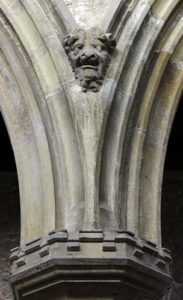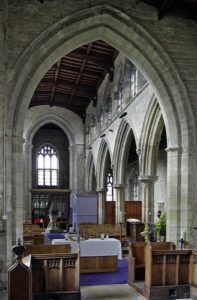East Markham is a small rural village built on a slight ridge about seven miles south of Retford. The church is on the southern edge of the village. There was a church recorded here in the Domesday Book, but the present building is 15thC Perpendicular and is a splendid building more reminiscent of the great East Anglian churches.
The nave has a lovely clerestory with large perpendicular windows. At the west end is a tall square tower with battlements and eight tall pinnacles. There is a blocked off entry at the base of the west wall with a perpendicular window above and clock. There are more battlements round the top of the nave, side aisles and chancel. At the end of the nave and chancel is a carved stone cross. There are beautifully carved stone gargoyles along the sides of the side aisles. The south porch is also battlemented with pinnacles.
This doorway was locked and there was a sign directing you to the small doorway on the north wall. This had a sign on the inside with two contact numbers to phone if you had problems getting out. Failing that ring the bells….
Inside it is a beautiful church full of light which was carefully restored in the 19thC. The church was still decorated for Easter with colourful bowls of flowers. Beside the south door is a wooden poor box with three locks. The vicar and both churchwardens would have keys and all three would have to be present to open it.
At the back of the tower is an open carved wooden screen. In front is the font, a queer looking structure with a bowl on what can best be described as ‘octopus legs’. All becomes clear when you realise the base is actually the upturned remains of an earlier font which had flying buttresses and now supports a newer bowl. Next to it is the organ painted a shade of pale violet which is thought to have come from a long demolished grand house. This is next to the blocked off end of the north aisle which is now a vestry.
Multangular pillars with battlemented capitals and pointed arches separate nave and side aisles. There are delightful carvings of animal heads at the base of the arches. The floor is stone slabs with a deep blue/violet carpet down the centre. Above is a wooden roof with carved bosses. Chairs now replace pews.
There is a simple wood alter at the east end of the north aisle with a stained glass window above. The end of the south aisle is the lady chapel with a a statue of the Virgin Mary holding the Christ Child on a pillar. It is separated from the nave by a carved wooden screen thought to be Jacobean and a similar date to the pulpit and altar rail in front of the high altar. The south alter is covered with a blue cloth and there are blue curtains behind the altar. Above is the Markham stained glass window dated 1885 and dedicated to Judge Markham the founder of the church (tomb in the chancel) and his son Sir John Markham.
On the floor under a carpet is the beautiful brass of Milicent Meryng who died in 1419. This would probably have been on top of her tombstone. It shows here in long flowing robes with a high waisted dress and wide wimple headdress and hands praying. She had three husbands. Her first was Sir Nicholas Burdon who died at the Battle of Shrewsbury. He second was Judge John Markham and she was the mother of Sir John Markham. Her third husband was Sir William Meryng.
There is a modern free standing altar in front of the pointed chancel arch which has a simple wooden cross above. The carved wooden choir stalls were given by Mr & Mrs CJ Hempsall in memory of their son who was accidentally killed in 1930. The carved wooden pulpit is Jacobean. The alter rail is a similar date.
In the chancel is the massive marble tomb of Judge Markham dated 1409 which has a marble inscription round the top asking for prayers for his soul. He was the judge who who drew up the deposition document deposing Richard II in 1399 and received the crown which Richard ’resigned’ in favour of Henry Bolingbroke. On the base are blank shields. The top is defaced by graffiti with names dated 1647 and gaming boards for Nine Men’s Morris.
The high altar has gilded angels at the corners holding tall candlesticks. Above is a 19thC stained glass window designed by JN Comper in predominantly shades of white and grey with some blue, yellow and red. In the centre is the Virgin Mary holding the Christ Child. She is flanked by St hugh, Bishop of Lincoln, holding a book. Next to him is St John the Baptist holding the Lamb of God with a halo. On the other side of Mary is St Paul holding a sword and St Cuthbert holding a crozier and a crowned head.
Above are smaller windows with St George in armour and St William of York in the centre. On either side are heraldic shields.
This is a delightful church. John Betjeman describes it as the Cathedral of the Tent Valley and it is an apt description. The church features in Simon Jenkin’s England’s Thousand Best Churches and is still in use. We were pleased to find it open. There is plenty of on street parking around the church and a toilet at the back of the tower.










